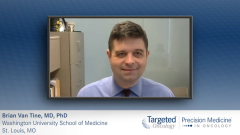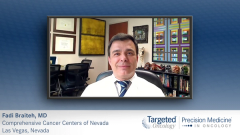
Unmet Needs in GIST
Brian Van Tine, MD, PhD, and Fadi Braiteh, MD, discuss unmet needs in the treatment of gastrointestinal stromal tumors (GISTs) and look to the future in terms of the evolving field.
Brian Van Tine, MD, PhD: I’m going to add a caveat to the next question by saying the following: I think the GIST [gastrointestinal stromal tumor] population is well treated, especially in the metastatic setting. We see an amazing overall survival, but we’re not curing people once it’s spread, for the most part. In your opinion, what are the unmet needs? Where do we need to go next?
Fadi Braiteh, MD: Again, we’re helping patients. They’re living longer. They’re having the chance to have other comorbidities that may be age related, not just the adverse events that emerge from the drugs or the surgeries we’re doing. Like in other areas of oncology, when we have long-term survivorship, we are the primary care doctors taking care of these patients. We know it’s a matter of time before we will be telling them we are running out of options—out of surgical options, if any, out of systemic therapy options, and out of phase 1 trials. Ideally, I wish we had a common database to exchange data. In the community, we don’t know what we don’t know about other options. Maybe someone is not familiar with the NTRK inhibitors and they recognize that a patient has an NTRK rearrangement. Luckily, now with these reports from the larger NGS [next-generation sequencing] companies, they give you suggestions. Often, there is a phone call or an email from the medical director. They say, “Did you realize there is this and that?” And, “You need to do this.” I think this is the largest benefit to the community.
But as you mentioned, we need the same for other malignancies treated with TKIs [tyrosine kinase inhibitors] or other biologics. What is life like after these patients progress? There may be resistance mutations or novel driver mutations emerging. It’s not a bad idea, in my opinion, to try to lock in the patient for consultation with a tertiary center. Because of the pandemic [COVID-19], telemedicine has really evolved. It’s not going to go away. I don’t do it that much because our patients with cancer come in, but it has been a great tool for patients who are having second opinions or consultations with tertiary centers. I think it’s a model that we can develop quickly so the patient interacts with a provider from a tertiary center, so it’s not just the physician initiating the contact; it will take the burden off the back of a physician who may be very busy. We’re all very busy. I would encourage even the support groups and the chat rooms to demand second opinions via telemedicine. There is no need for travel, even post-pandemic, to have input on a case. If more input is needed, then you can arrange for travel. I do believe there is a golden opportunity here for the GIST community—patients, researchers, clinicians, and sponsors—to build on that model.
Brian Van Tine, MD, PhD: I would say that the GIST community is very fortunate to have an advocacy group called the Life Raft Group. Life Raft has worked hard to not only throw educational events, but to do physician matching. They’re really a neat organization. For people listening to this who don’t know about Life Raft, I would encourage you to go to their website and learn more about the group. I think this allows for that partnership. I think it helps bridge people like you and me, even though we’re now new best friends.
On top of that, if you ask what the unmet need is, I’d really like to know why GIST doesn’t respond to immunotherapy. We’ve done the trials of nivolumab, and we’ve done the trials of ipilimumab and nivolumab. They’re negative. Ronald DeMatteo, MD, FACS, had some beautiful early data looking at IDO inhibitors. I want to know what we need to do to get to the point where we can treat these and potentially get to these durable long-term response rates. But having 3 drugs enter a space in very rapid succession and having this conversation is incredibly important and really neat. Three years ago, I wasn’t expecting there to be so many transformations and steps forward. It’s exciting.
Fadi Braiteh, MD: What’s interesting about the 2 newest drugs that made it to the market last year, it’s that first FDA approval in GIST. It’s unlike imatinib, sunitinib, and regorafenib, where in each of them the approval in GIST on the line of development of the drug followed approval, of course, in CML [chronic myeloid leukemia], renal cell carcinoma, and others, and colorectal cancer. This is really showing that the developers—our partners, scientists, and business people in biotech and pharmaceutical companies—recognized the unmet need and responded to it by dedicating resources to develop such drugs. Hopefully this will continue further with other orphan cancers, other rare cancers. Not to put a plug in, but I remember 15 years ago there were no cholangiocarcinoma trials, for example, unless it was investigator initiated. We’ve seen a major switch in that. All cancers ultimately are rare cancers, because that’s what we need to break them into subsets. A rare cancer like GIST is a cohort of very rare cancers, as we’ve been talking about for the last 45 minutes. It’s important to recognize this subgrouping of diseases.
Brian Van Tine, MD, PhD: I’d like to give a shout out to the entire sarcoma field. We have 150 or more diseases with a lot of molecular targets. When your drug works on that target, we’ve got a cancer for you. With that being said, I hope everybody has found this to be extremely informative. I’d really like to thank you, Dr Braiteh. I found you to be very insightful and I’ve loved this discussion. We’d also like to thank our audience for watching this Targeted Oncology™ presentation on precision medicine. We hope you found this discussion to be useful and informative, and we hope to talk to you soon.
Transcript edited for clarity.















































